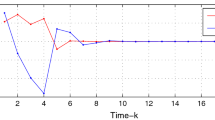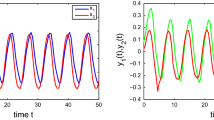Abstract
This paper is devoted to the passivity analysis of an array model for coupled inertial delayed neural networks (NNs) with impulses under different network structures, namely directed and undirected topologies. Firstly, utilising the information of eigenvectors for the directed coupling matrix, a new Lyapunov functional is constructed, by which, together with the aid of some inequality techniques and network characteristics, the two sets of sufficient criteria are established to, respectively, guarantee the strictly input passivity and strictly output passivity of the impulsive network with directed coupling. Secondly, benefited from the properties of the undirected coupling matrix, some more concise conditions that are easier to be verified for the passivities of the undirected coupled network accompanied by impulsive effects are proposed. Finally, two numerical examples are designed to execute the verification of the derived theoretical results.












Similar content being viewed by others

References
H A Rowley, S Baluja and T Kanade, IEEE Trans. Pattern Anal. 20, 23 (1998)
A S Miller, B H Blott and T K Hames, Med. Biol. Eng. Comput. 30, 449 (1992)
B K Bose, Proc. IEEE 82(8), 1303 (1994)
R Manivannan, R Samidurai, J D Cao, A Alsaedi and F E Alsaadi, Neural Netw. 87, 149 (2017)
J D Cao and M Xiao, IEEE Trans. Neural Netw. 18(2), 416 (2007)
R X Li, J D Cao, A Alsaedi and B Ahmad, J. Franklin Inst. 354(7), 3021 (2017)
J D Cao and R X Li, Sci. China Inf. Sci. 60(3), 032201 (2017)
K Babcock and R Westervelt, Physica D 23, 464 (1986)
D E Angelaki and M J Correia, Biol. Cybern. 65, 1 (1991)
J F Ashmore and D Attwell, Proc. R. Soc. London. B: Biol. Sci. 226, 325 (2014)
H Y Zhao, L Chen and X Yu, Acta Phys. Sin. 60, 1 (2011)
C Li, G Chen, X Liao and J Yu, Eur. Phys. J. B 41, 337 (2004)
M Prakash, P Balasubramaniama and S Lakshmananc, Neural Netw. 83, 86 (2016)
J T Qi, C D Li and T W Huang, Neurocomputing 161, 162 (2015)
J Q Hu, J D Cao, A Alofi, A AL-Mazrooei and A Elaiw, Cogn. Neurodyn. 9, 341 (2015)
S Dharani, R Rakkiyappan and J H Park, Neurocomputing 227, 101 (2017)
S Lakshmanan, M Prakash, C P Lim, R Rakkiyappan, P Balasubramaniam and S Nahavandi, IEEE Trans. Neural Netw. Learn. Syst. 29(1), 195 (2018)
S Lakshmanan, C P Lim, M Prakash, S Nahavandi and P Balasubramaniam, Neurocomputing 230, 243 (2017)
V Belevich, Classical network synthesis (Van Nostrand, New York, 1968)
G L Santosuosso, Automatica 33(4), 693 (1997)
C W Wu, IEEE Trans. Circuits Syst. I: Reg. Papers 48(10), 1257 (2001)
L Xie, M Fu and H Li, IEEE Trans. Signal Process. 46(9), 2394 (1998)
W Yu, IEEE Trans. Circuits Syst. I: Reg. Papers 46(7), 876 (1999)
R X Li, J D Cao and Z W Tu, Neurocomputing 191, 249 (2016)
R Sakthivel, A Arunkumar, K Mathiyalagan and S M Anthoni, Appl. Math. Comput. 218, 3799 (2011)
J L Wang, H N Wu, T W Huang and S Y Ren, IEEE Trans. Cybern. 45(9), 1942 (2015)
Z G Wu, P Shi, H Y Su and J Chu, IEEE Trans. Neural Netw. 22(10), 1566 (2011)
J Q Lu, D W C Ho, J D Cao and J Kurths, IEEE Trans. Neural Netw. 22(2), 329 (2011)
P C Wei, J L Wang, Y L Huang, B B Xu and S Y Ren, Neurocomputing 168, 13 (2015)
X S Yang, J D Cao and D W C Ho, Cogn. Neurodyn. 9, 113 (2015)
P Baldi and A F Atiya, IEEE Trans. Neural Netw. 5(5), 612 (1994)
C I Byrnes, A Isidori and J C Willems, IEEE Trans. Autom. Control. 36(11), 1228 (1991)
S I Niculescu and R Lozano, IEEE Trans. Autom. Control. 46(3), 460 (2001)
W L Lu and T P Chen, Physica D 213(2), 214 (2006)
W W Yu, J D Cao and J Wang, Neural Netw. 20, 810 (2007)
S Boyd, L E Ghaoui, E Feron and V Balakrishnan, Linear matrix inequalities in system and control theory (SIAM, Philadelphia, 1994)
W Zhang, C D Li, T W Huang and J Tan, Neural Comput. Appl. 26, 1781 (2015)
J D Cao and Y Wan, Neural Netw. 53, 165 (2014)
Acknowledgements
This work was jointly supported by the National Natural Science Foundations of China (Nos 61573096, 61833005 and 11861060), the Engineering Foundation of Jiangsu Province of China (No. BRA2015286), the Fundamental Research Funds for the Central Universities, the Postgraduate Research and Practice Innovation Program of Jiangsu Province (No. KYCX17_0042), and the Youth Education Program of Xizang Minzu University (No. 18MDX01).
Author information
Authors and Affiliations
Corresponding author
Rights and permissions
About this article
Cite this article
Ding, Xs., Cao, Jd. & Alsaadi, F.E. Passivity analysis of coupled inertial neural networks with time-varying delays and impulsive effects. Pramana - J Phys 91, 69 (2018). https://doi.org/10.1007/s12043-018-1629-7
Received:
Revised:
Accepted:
Published:
DOI: https://doi.org/10.1007/s12043-018-1629-7
Keywords
- Inertial neural networks
- passivity
- impulsive effects
- directed and undirected topologies
- time-varying delays



